(Press-News.org) PROVIDENCE, R.I. [Brown University] — Brown University sociologists have developed a device to gather more reliable data about risky sexual behavior among Ethiopian teenagers and young adults than conventional face-to-face interviews can produce. Simple, portable, low-cost, and low-tech, the group's new nonverbal response card allows respondents to communicate nonverbally and confidentially during face-to-face interviews. Professors of sociology David Lindstrom and Dennis Hogan, and postdoctoral research associate Megan Klein Hattori published their findings in the December issue of Studies in Family Planning.
Successful programs to combat the spread of HIV/AIDS require accurate information about the prevalence of risky sexual behavior among populations. Obtaining that information can often be tricky due to intentional misreporting on sensitive topics. A number of innovations in questionnaire methodology have been developed to address reporting bias, but those techniques can be expensive, technically unreliable, and dependant on basic literacy.
The group's new nonverbal response card is an 8.5-by-11 inch laminated sheet of paper with a respondent side and an interviewer side. Each side is divided into 35 cells with a small hole punched through the center of each cell. On the respondent side of the card, the cells contain written and color-coded responses. The numeric responses, for questions such as the number of sexual partners or age at first sex, range from 0-25, marked with both a written number and vertical bars for tallying (for example, II for 2 and IIIII IIIII for 10). The non-numeric responses (yes, no, and does not apply) are written in local languages and also color-coded with green, red, and blue. On the interviewer side of the card, each cell contains a unique survey-specific three-digit number.
For sensitive portions of interviews, the respondent selects a card and holds it up. The interviewer asks the question and the
respondent indicates the answer by inserting a stick through the hole of the appropriate cell. For example, the interviewer asks, "Have you ever had sexual intercourse? Point to green for yes, red for no." The respondent pokes the stick through any of the green or red cells and the the interviewer records the three digit number of the cell through which the stick is protruding. The numbers are later entered into data files and decoded, which allows for full confidentiality.
The research team tested the card in a survey of 1,269 Ethiopian men and women aged 13 to 24. The adolescent and young adult respondents were from rural communities and small urban centers in southwestern Ethiopia, which is a predominantly Muslim population. The respondents were interviewed at home (often with parents or other family members nearby) on topics including aspirations, food insecurity, and HIV knowledge, as well as romantic relationships, sexual intercourse, and condom knowledge and use. One half of the study sample used the cards, while the other half gave traditional verbal responses to interviewers.
The researchers found that respondents were twice as likely to report having premarital sex when using a nonverbal response card. The effect of the response method on the willingness to report risk of acquiring HIV in the 12 months prior to the survey were "especially striking." Virtually no respondents answering the questions verbally admitted to being at risk of acquiring HIV, compared to 3.8 percent of the respondents who used the card method.
The researchers found that young people over-report knowledge of condoms when they give verbal responses: About half of the single respondents giving verbal responses reported knowing where to obtain a condom, compared to only 37 percent of the single respondents in the card group.
"The difference in reported knowledge to access to condoms presents additional challenges for public health programs by suggesting that conventional survey estimates may significantly overestimate this knowledge, and most likely condom use as well, among subgroups who are often the target of outreach programs," the authors wrote.
The response cards cost about $2 to produce, are highly portable and reliable, and are particularly useful in low-income rural settings where illiteracy is common.
"It's clear that more sophisticated and costly survey technologies are not always the best solution when it comes to these types of surveys and questions," said Lindstrom. "I hope this method is picked up and tried in research settings where sensitive questions are being asked."
INFORMATION:
Lindstrom, Hogan, and Hattori are all affiliated with the Population Studies and Training Center at Brown. Their research group also included Tefera Belachew and Fasil Tessema of Jimma University in Ethiopia, and Craig Hadley of Emory University. This work was supported by the David and Lucile Packard Foundation, the Mellon Foundation, the Compton Foundation, and the National Institutes of Health.
New survey device gets better information on teenage sexual behavior
2010-12-15
ELSE PRESS RELEASES FROM THIS DATE:
Special section on stigma in Perspectives on Psychological Science: Group differences, not deficits
2010-12-15
Psychological scientists are faced with the arduous task of identifying distinctions between humans without stigmatizing groups of people based on these differences. In this special section of Perspectives on Psychological Science, a journal of the Association for Psychological Science, experts present reasons for why differences in gender, race, sexual orientation, and culture should not be framed as deficits within the field of psychology.
Stigma From Psychological Science: Group Differences, Not Deficits—Introduction to Stigma Special Section (http://pps.sagepub.com/content/5/6/687.full) ...
CSHL scientists identify elusive neuronal targets of deep brain stimulation
2010-12-15
Cold Spring Harbor, N.Y. – Shooting steady pulses of electricity through slender electrodes into a brain area that controls complex behaviors has proven to be effective against several therapeutically stubborn neurological and neuropsychiatric disorders. Now, a new study has found that this technique, called deep brain stimulation (DBS), targets the same class of neuronal cells that are known to respond to physical exercise and drugs such as Prozac.
The study, led by Associate Professor Grigori Enikolopov, Ph.D., of Cold Spring Harbor Laboratory (CSHL), is the cover ...
The ethics of biofuels
2010-12-15
In the world-wide race to develop energy sources that are seen as "green" because they are renewable and less greenhouse gas-intensive, sometimes the most basic questions remain unanswered.
In a paper released today by the School of Public Policy at the University of Calgary, authors Michal Moore, Senior Fellow, and Sarah M. Jordaan at Harvard University in the Department of Earth and Planetary Sciences, look at the basic question of whether these energy sources are ethical.
In addition to arguing that the greenhouse gas benefits of biofuel are overstated by many policymakers, ...
Researchers discover new signaling pathway linked to inflammatory disease
2010-12-15
Scientists at the University of California, San Diego School of Medicine have described for the first time a key inhibitory role for the IL-1 signaling pathway in the human innate immune system, providing novel insights into human inflammatory bowel disease (IBD) and potential new treatments.
The research, led by Jose M. Gonzalez-Navajas, PhD, and Eyal Raz, MD, a professor of medicine at UC San Diego, is published as a Brief Definitive Report in the December issue of The Journal of Experimental Medicine.
The researchers report that signaling by the interleukin 1 receptor ...
Fighting flu in newborns begins in pregnancy
2010-12-15
A three-year study by Yale School of Medicine researchers has found that vaccinating pregnant women against influenza is over 90 percent effective in preventing their infants from being hospitalized with influenza in the first six months of life. Published in the December 15 issue of Clinical Infectious Diseases, the study builds on preliminary data the research team presented last year at the Infectious Disease Society of America in Philadelphia.
Influenza is a major cause of serious respiratory disease in pregnant women and of hospitalization in infants. Although the ...
Scripps scientists see the light in bizarre bioluminescent snail
2010-12-15
Two scientists at Scripps Institution of Oceanography at UC San Diego have provided the first details about the mysterious flashes of dazzling bioluminescent light produced by a little-known sea snail.
Dimitri Deheyn and Nerida Wilson of Scripps Oceanography (Wilson is now at the Australian Museum in Sydney) studied a species of "clusterwink snail," a small marine snail typically found in tight clusters or groups at rocky shorelines. These snails were known to produce light, but the researchers discovered that rather than emitting a focused beam of light, the animal uses ...
Mothers' diets have biggest influence on children eating healthy
2010-12-15
EAST LANSING, Mich. — As health professionals search for ways to combat the rise in obesity and promote healthy eating, new research reveals a mother's own eating habits – and whether she views her child as a 'picky eater' – has a huge impact on whether her child consumes enough fruits and vegetables.
A study by professor Mildred Horodynski of Michigan State University's College of Nursing looked at nearly 400 low-income women (black and non-Hispanic white) with children ages 1-3 enrolled in Early Head Start programs. Results show toddlers were less likely to consume ...
IBEX makes first images of magnetotail structures, dynamic interactions occurring in space
2010-12-15
Invisible to the naked eye, yet massive in structure around the Earth is the magnetosphere, the region of space around the planet that ebbs and flows in response to the million-mile-per-hour flow of charged particles continually blasting from the Sun. NASA's Interstellar Boundary Explorer (IBEX) spacecraft, designed to image the invisible interactions occurring at the edge of the solar system, captured images of magnetospheric structures and a dynamic event occurring in the magnetosphere as the spacecraft observed from near lunar distance.
The data provides the first ...
UT researcher finds power and corruption may be good for society
2010-12-15
They are familiar scenes: politicians bemoaning the death of family values only for extramarital affairs to be unveiled or politicians preaching financial sacrifice while their expense accounts fatten up.
Moral corruption and power asymmetries are pervasive in human societies, but as it turns out, that may not be such a bad thing.
Francisco Úbeda, an evolutionary biology professor at the University of Tennessee, Knoxville, and Edgar Duéñez of Harvard University found that power and corruption may play a role in maintaining overall societal cooperation.
A report of ...
Y-90 radioembolization offers promise for late-stage liver cancer
2010-12-15
INDIANAPOLIS -- The latest weapon against inoperable liver cancer is so tiny that it takes millions of them per treatment, but according to interventional radiologists at the Indiana University School of Medicine, those microscopic spheres really pack a therapeutic punch.
The glass spheres contain a radioactive element, yttrium-90, more commonly known as Y-90, which emits radiation for a very limited distance so that healthy tissue around the tumor remains unaffected. (2.5mm or less than 1/16th inch in soft tissue).
Y-90 microsphere radioembolization is an FDA-approved ...



